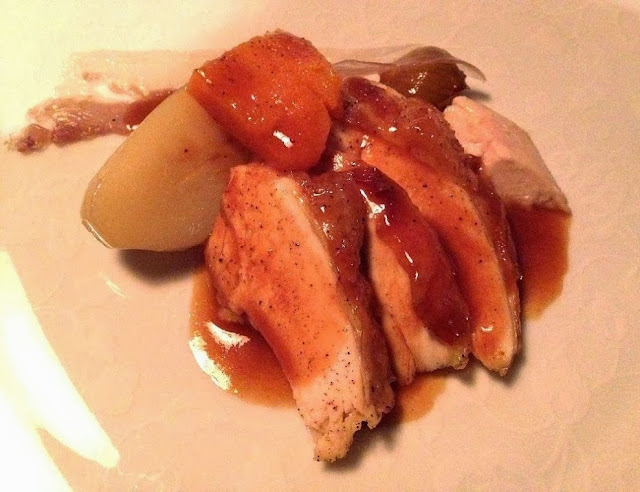You are in Rome looking for some fine dining, a memorable experience, you end up to La Pergola. If it is Monaco then Le Louis XV will be perfect, and so is Noma in Copenhagen, or El Celler de Can Roca near Barcelona (if you ever manage to make a reservation). But when you go to Paris, it can be tricky.
Paris, capital of France, or of gastronomy to my eyes, has 10 three star restaurants and much more with one or two stars. Pricing at all three star places is about on the same level, with the majority of them offering a more affordable lunch menu. The exceptions that I can think of are L'Ambroisie, Ducasse (EDIT: now starting at 85euros for lunch) and L'Abeille. Service is pretty much everywhere impeccable, the ingredients used are the best you can find and as most of them are in the city centre you can easily access them.
So which one to chose? For me, Pierre Gagnaire was the number one on the list. His first and flagship restaurant opened in 1996 is near the Champs Elysees on the ground floor of the Hotel Balzac. He received 3 Michelin stars and 5 toques by Gault-Millau soon after. He has restaurants in other cities like London, Las Vegas, Courchevel etc. His style is easily recognisable, you see one plate with many satellite plates next to it, you know it is Gagnaire.
Chef Gagnaire thinks his talent is to consive tastes, to combine many elements, textures, flavors and tastes. Many bloggers or more regular customers think that dining at Pierre Gagnaire is like a roller coaster. It can be bad or it can be heavenly good. My meal was fascinating, some plates were good some were outstanding.
I couldn't agree more about his talent.
To start we were offered bread and butter. Bread was of three kinds, brioche, brown bread and small baguette, served hot, having great flavor and texture. Butter was either salted or with lime, with the latter to be amazingly good.
And then the amuse-bouches, four dishes, nine preparations. Gagnaire must be the hardest one to review for a blogger. First plate, in the central small bowl, some squared gelees by alcohol drinks, a bit sweet, a bit acid. The black semi sphere was tuna covered by squid ink. Second plate, two different preparations of Parmesan crackers.
Third plate in the center, bread sticks in strong olive oil, olives, hazelnut in edible gelatin. Forth plate toasted thinly sliced bread with hazelnuts, pistachio and raisins.
The first medley of dishes then followed. The central dish was a slice of goose foiegras. Smoother, finer and creamier than the most used duck foie gras. Bortsch made in gelee,(made from tomato and beetroot), and on top some quince pate with Gewurztraminer wine. This main dish of the course was to be combined with all of the other satellite dishes. Salade Felicia, Tamarillo creme glacee, Beaujolais nouveau wine, red cabbage, slice of toasted rutabaga, which is a root vegetable and puntarelle. This course had some very interesting elements, acid, sweet, bitter flavors, all of which were paired to the fatty metallic taste of the foie gras.
Haddock souffle, white and red cabbage, melted endive and radicchio. Amazing combination, the souffle had velvety texture and smokey flavor. Saint-Jacques, walnuts, chestnuts sitting on top of a broccoli and horseradish puree. The latter overpowering the broccoli, but pairing very well with the delicate Saint-Jacques. A great course, that I will remember for a long time.
A big whole roasted poularde of Bresse, the famous region, home of the best chickens in the world was presented to every table and then went back to the kitchen to be carved. The difference between the poularde and the poulet is that the first one has its genitals removed, a process that helps it have a finer and more tender meat, making it more suitable for roasting.
The supreme was cut in slices and then coated with its cooking juices and tamarind, accompanied by pearl onions, and Jerusalem artichokes. The fat of the thighs was cooked to become crispy, served with gratin of pear, celery, crozets and Blue de Termignon cheese. Again this was an excellent dish with strong flavors, well balanced cooking and strange combinations that really worked together.
The desserts de Noel, A variation of the regular desserts that you can find all year long, consisted of two servings, each one with multiple courses.
The main plate had the best one of the first desserts. A thin crispy tart with red fruit jam and cucumber sitting on top of coconut cream. Odd combination, you don't usually find cucumber in desserts, but it worked great, had very nice aromas and was refreshing. The bowl had beans with liquorice gel, interesting, intriguing and delicious. The chocolate gateau with orange was just good.
The second serve had the red fruits bouche de Noel as the main plate. After it was presented to the table, the server carefully cutted a slice and served it as seen on top of a biscuit covered with lemon. Amazing.
That was seriously a big amount of food.
The service was attentive, relaxed and very professional.There were some empty tables during my lunch, but I would suggest that you make a reservation to avoid surprises.






























No comments:
Post a Comment